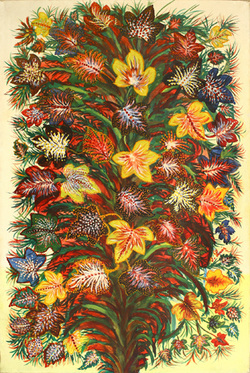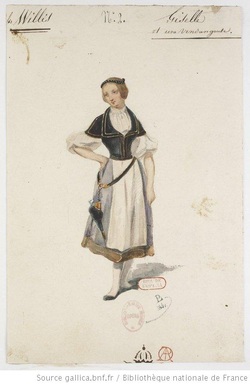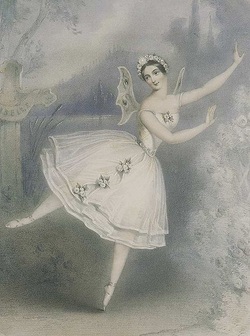 Seraphine, Feuilles D'automne 1928-30 Seraphine, Feuilles D'automne 1928-30 Séraphine (directed by Martin Provost), recently screened at the French Embassy is a movie about the triumph of human character over circumstance. The story begins with a woman hunched over, collecting mud and water from a pond. She wears a blue shawl. Her body is dowdy, and her dress shapeless. She hums to herself and looks about her with adorable, inquisitive blue-grey eyes. She likes to sit in a tree and smell the air with the breeze blowing her forever unkept hair about. This is Séraphine, a servant for patrons in a fairly small town at the dawn of World War I in France. She manages, despite the plethora of errands she runs during the day, to paint. And paint she does. By creating mixtures out of nature and some bought supplies. Some stolen, as well. However she needs to paint, she does. She sings to herself as she paints, much to the non-entertainment of the dwellers one floor below her. She is lovable, weird, as awkward as she is natural, and very, very much herself. One of the tenants, Wilhelm Uhde, is renting a flat from Séraphine’s mistress. Uhde is a frontrunner in the art world and a well noted critic. He takes a liking to Séraphine and she to him. She lets him know she paints and the word of Séraphine’s exploits travels to her mistress; who of course, demands to see Séraphine’s work, only so she can mock it and tell Séraphine to give up. The mistress’s son, stands up for Séraphine’s work, and keeps his mother from throwing it away altogether. The piece is laying to the side on the wall in the dining room, when it is noticed by Uhde during a dinner. He demands to know who the painter is and the mistress reluctantly has to admit that it is Séraphine. Uhde becomes Séraphine’s patron and protector. He has to encourage her to sell her work and she seems reluctant because she is afraid of losing her place. Of breaking with the traditions within her own life of servitude. But Uhde convinces her and she agrees to exhibit and sell her work. It is a “pure” relationship as Uhde informs Séraphine that he will never marry a woman in his life. Uhde has to leave France as the War progresses but comes across her work at a local show many years after the War has ended. The two strike up a relationship once more and Séraphine’s art sells as part of what is known as the naïve genre. She continues to paint, but her relationship with Uhde is strained due to her spending habits. She spends more than is coming in and on the oddest things. Such as a wedding dress, when there is no actual wedding. Séraphine’s eccentricities descend into a sad outright madness. She dons her wedding dress and by herself in bare feet, walks through the town knocking on doors and leaving empty silvered candleholders on the doorsteps. At the top of the town stairs are local authorities, waiting to take Séraphine away, in a van. She seems to know why they are there and submits without any confrontation. She just gets into the van, barefoot and in her beautiful dress. The cinematography throughout the film is breathtakingly clear, as if to reflect the purity of Séraphine’s soul and intentions. Uhde attempts to visit Séraphine, but she is too far gone. He makes her more comfortable, by buying her a place in a home where she can be alone. And the final scene is of Séraphine, sitting down on a chair in the middle of a field by herself under a large, comforting tree. Séraphine had the courage to tell a story of a world that begins and ends within herself. She became known as Séraphine of Senlis. It is still not known exactly how her paintings were made. They are of fruits and trees, as if in a child’s dream. By Sarah Bahl The image is from madamepickwickartblog.com  A rendition of Giselle (1841) A rendition of Giselle (1841) To escape to the Kennedy Center in morbidly hot weather is a gift of itself. The plush red carpet is comforting and the hum of persons being shuttled in an orderly fashion to their seats is part of the veneer. Giselle being performed by the Paris Opera Ballet at the Kennedy Center is a gem to see. According to, La Maison Française’s information letter, the Paris Opera Ballet has not been to the Nation’s Capitol in 19 years. The ballet runs through the 8th. The First Act of the story begins with bright and natural woodland scenery. The floor is kept a simple wood and the costumes are elegant and rustic to reveal the simple peasant Giselle (danced by Isabelle Ciaravola). Her dress adds to the quaint rhythms of the peasants' motions as they celebrate the harvest. There are two men in Giselle’s life. One who she accepts and the other, she keeps at a distance. Her preferred man is Prince Albrecht of Silesia, who, tired of court life decides to dress as a peasant and woo the lovely and innocent Giselle. Her jealous suitor, the Gamekeeper Hilarion, unmasks Prince Albrecht, and in doing so reveals Albrecht to be already engaged to the noblewoman Bathilde, (dressed in highly refined and lushly embroidered costume to starkly contrast with Giselle being herself.) The sensitive Giselle dances to reveal her confusion and pain. She dies from the pain of her lost love and the competing men nearly duel over her.  Carlotta Grisi as Giselle (1841) Original Source Unknown Carlotta Grisi as Giselle (1841) Original Source Unknown The Second Act, is absolutely beautiful in an otherworldly manner, with a darkened woodland scene, as Giselle, now deceased has joined The Wilis, the spirits of young women, with the misfortune of death brought upon them before being wed. The dancers, in white spirit garb, are all the same height, and dance in unison to celebrate their current fate within the black woodland night. The Wilis enact revenge for their broken hearts by wooing young men into their world, never to return. Their first victim is Hilarion. Then, it would be Albrecht, as well, except Giselle convinces the other spirits to let him go, because she still likes him so much. And so the story ends. Giselle returns to her world and Albrecht remains within his own, much as it all began. The original costumes represented are by Paul Lormier, for the ballet’s initial 1841 production. At the time, Romanticism was in high fashion among the general populace in France and the costumes and ideals behind the ballet marketed to this particular niche. Lormier did much historical study to create as realistic a garb as possible. The current costumes represent the spirit of his work. By Sarah C. Bahl |
Archives
June 2017
Categories
All
|
 RSS Feed
RSS Feed